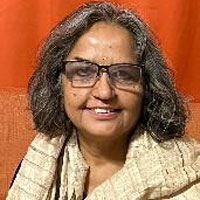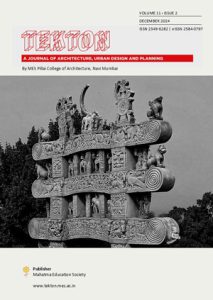Amita Sinha and Smriti Dhariwal
Tekton
Tekton: Volume 11, Issue 2, December 2024
pp. 70 – 83
 Amita Sinha is the author of Cultural Landscapes of India: Imagined, Enacted, and Reclaimed (University of Pittsburgh Press, 2020) that won the 2022 J.B. Jackson Book Award and Landscapes of India: Forms and Meanings (University Press of Colorado, 2006; reprinted by Gyan Books, 2023). She is the co-editor of Cultural Landscapes of South Asia: Studies in Heritage Conservation and Management (Routledge, 2017). A former Professor of Landscape Architecture at the University of Illinois at Urbana Champaign, she is currently teaching at Indian Institute of Technology, Banaras Hindu University.
Amita Sinha is the author of Cultural Landscapes of India: Imagined, Enacted, and Reclaimed (University of Pittsburgh Press, 2020) that won the 2022 J.B. Jackson Book Award and Landscapes of India: Forms and Meanings (University Press of Colorado, 2006; reprinted by Gyan Books, 2023). She is the co-editor of Cultural Landscapes of South Asia: Studies in Heritage Conservation and Management (Routledge, 2017). A former Professor of Landscape Architecture at the University of Illinois at Urbana Champaign, she is currently teaching at Indian Institute of Technology, Banaras Hindu University.
amitasinha12@hotmail.com
 Smriti Dhariwal graduated from the School of Environmental and Design Architecture at Navrachana University in 2023 and is currently affiliated with design firm Nomads in Surat, Gujarat. She is particularly intrigued by story-telling traditions and seeks to understand the nuances of place-making through narratives.
Smriti Dhariwal graduated from the School of Environmental and Design Architecture at Navrachana University in 2023 and is currently affiliated with design firm Nomads in Surat, Gujarat. She is particularly intrigued by story-telling traditions and seeks to understand the nuances of place-making through narratives.
smritidhariwal68@gmail.com
ABSTRACT
Vrindavan, associated with Lord Krishna’s lila (play), evolved over half a millennium into a pilgrim town on the banks of the River Yamuna in the Braj region. The coded language of myths and their grounding in riverfront groves preserves collective memories and represents living heritage. The northeastern part of Vrindavan’s historic core on the Yamuna Riverfront is selected for detailed observations and documentation to understand this living heritage. Mapping revealed that myths are enacted by devotees in ‘making’ places through active engagement with the physical environment. The built environment and the riverfront are transformed in place-making by devotees, in the process producing ephemeral landscapes, and adding to the permanent structures already in place. These cultural practices are salient in sustaining collective memories of Krishna’s play in Vrindavan. The historic core is currently facing many challenges as a result of increasing religious tourism. Preserving it as a historic urban landscape entails untangling the complex connections between tangible and intangible aspects of heritage, especially the important role of place narratives in shaping beliefs, values, and ritual practices.
KEY WORDS
place-making, place narratives, living heritage, temples, monuments, riverfront


